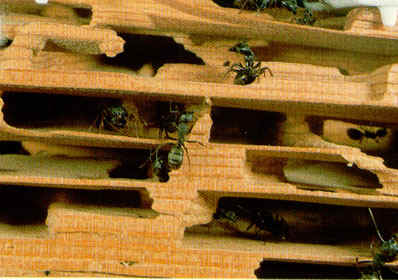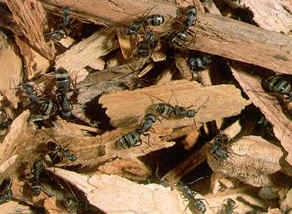 A colony consists of the adult forms and brood. The adult forms include a queen and workers of various sizes. Winged forms are produced in late summer and remain in the colony until mating flights occur the following spring. Activities of the workers include foraging, caring for the queen and brood, and excavating nest galleries. Carpenter ants have complete metamorphosis so brood will consist of eggs, larvae, and pupae. After mating, a queen initiates the colony and cares for her first brood until workers are produced. The new workers care for the expanding brood and excavate wood for brood space. Winged forms are produced in older established colonies.
A colony consists of the adult forms and brood. The adult forms include a queen and workers of various sizes. Winged forms are produced in late summer and remain in the colony until mating flights occur the following spring. Activities of the workers include foraging, caring for the queen and brood, and excavating nest galleries. Carpenter ants have complete metamorphosis so brood will consist of eggs, larvae, and pupae. After mating, a queen initiates the colony and cares for her first brood until workers are produced. The new workers care for the expanding brood and excavate wood for brood space. Winged forms are produced in older established colonies.Carpenter ants do not eat wood, but feed on a wide variety of plant and animal material. They are often found foraging on honeydew from aphids and are attracted to insects on vegetation.
Carpenter ants (Camponotus spp.) nest in wood and cause serious damage
when infestations occur in structures. Runways and galleries are excavated in timbers with opening or
"windows" cut at intervals to expel sawdust. Galleries of
carpenter ants have a smooth, sand-papered appearance as opposed to those
of termites which are filled with debris. Carpenter ants also excavate
galleries in sheet-foam insulation and have been found in stacks of
shingles, newspapers, and in other types of insulation. Old and new
structures may be infested, and sound as well as decayed, wet wood is
attacked.
structures. Runways and galleries are excavated in timbers with opening or
"windows" cut at intervals to expel sawdust. Galleries of
carpenter ants have a smooth, sand-papered appearance as opposed to those
of termites which are filled with debris. Carpenter ants also excavate
galleries in sheet-foam insulation and have been found in stacks of
shingles, newspapers, and in other types of insulation. Old and new
structures may be infested, and sound as well as decayed, wet wood is
attacked.
Colonies of carpenter ants can be a single unit, or the colony may consist of a main colony and several to many satellite colonies. Their nests are found in a number of locations. Some are totally contained in small areas such as within a single wall void or in a stump. Galleries of larger nests may encompass an entire structure with satellite nests in several locations. More importantly, parent colonies may be located outside the structure with satellites located within. The latter usually occurs when tree stumps are incompletely excavated or landscaping covers previously established nests in the lawn or adjacent areas. Also stacks of wood may be attractive to founding queens or to established colonies which immigrate to the wood, or a portion of the colony may establish a satellite nest there. Carpenter ants use chemical trails in their
 foraging activities and well-established trails may be readily visible in lawns. Trails also run underground and surface away from the nest. Trails are found along foundations, sidewalks, or flower beds and run under cement blocks, outdoor carpeting or layers of conifer needles. The number of foragers on trails is dependent upon temperature, time of day, season, and colony size.
foraging activities and well-established trails may be readily visible in lawns. Trails also run underground and surface away from the nest. Trails are found along foundations, sidewalks, or flower beds and run under cement blocks, outdoor carpeting or layers of conifer needles. The number of foragers on trails is dependent upon temperature, time of day, season, and colony size.